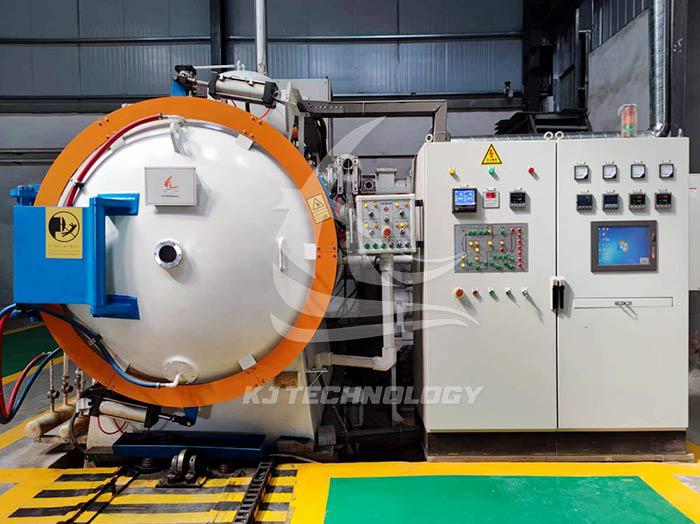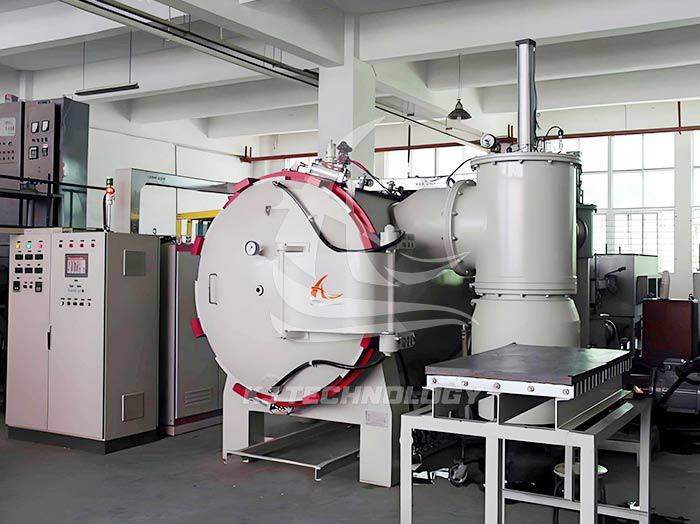Vacuum powder sintering furnace
 09-09-2025 Author: KJ technology
09-09-2025 Author: KJ technology
Vacuum powder sintering furnace is a specialized equipment for high-temperature sintering of powder materials in a vacuum or protective atmosphere environment, widely used in fields such as metal powder metallurgy, ceramic component production, and electronic component manufacturing. The following provides a detailed introduction from the aspects of working principle, structural composition, application fields, operation points, and common problems:
1. Working principle
The vacuum powder sintering furnace uses a vacuum system to exhaust the air inside the furnace, creating a low oxygen or oxygen free environment. Then, heating elements (such as resistance wires, induction coils, etc.) are used to heat the powder material at high temperatures, causing it to undergo a densification process and ultimately forming block shaped materials. Its core advantages lie in:
Avoid oxidation: A vacuum environment can prevent materials from reacting with oxygen at high temperatures, ensuring product purity.
Promote degassing: Vacuum conditions help to remove gases (such as adsorbed gases and volatile impurities) from the powder, reduce porosity, and increase material density.
Component control: By precisely controlling temperature and atmosphere, customized production of material chemical composition and microstructure can be achieved.
2. Structural composition
A vacuum powder sintering furnace typically consists of the following core components:
Furnace body: Adopting a double-layer structure, the inner layer is made of high-temperature resistant material (such as alumina polycrystalline fiber), the outer layer is made of steel shell, and the middle is equipped with air or water cooling system to achieve rapid temperature rise and fall.
Vacuum system: including vacuum pump, vacuum gauge, valves, etc., used for vacuuming and measuring furnace pressure.
Heating system: using methods such as resistance heating, induction heating, or microwave heating, equipped with temperature controllers and thermocouples to achieve precise temperature control.
Insulation system: Reduce heat loss and improve energy efficiency through multi-layer insulation screens or fiber materials.
Pneumatic/hydraulic system: used for furnace cover opening, material loading and unloading, and other operations.
Protective atmosphere system: can be filled with protective gases such as hydrogen and nitrogen to prevent material oxidation.
3. Application Fields
Metal powder metallurgy: producing high-precision metal components (such as gears and bearings), improving material density and mechanical properties through degreasing and sintering processes.
Ceramic component production: used for degreasing and sintering of fine ceramics such as aluminum nitride, silicon nitride, aluminum oxide, etc., to manufacture high-performance ceramic components.
Electronic component manufacturing: Processing ceramic powder materials, magnetic materials, LTCC (low-temperature co fired ceramics), MLCC (multi-layer ceramic capacitors), etc. to ensure product purity and performance.
Refractory alloy sintering: used in scientific research and military fields for powder forming sintering of tungsten, molybdenum and their alloys, as well as processing of hard alloys, high-temperature alloys and other materials.
4. Operation points
preparation:
Check if the water source, power source, and gas source are normal to ensure smooth water circulation in the cooling system.
Check the oil level of the vacuum pump, the tightness of the belt, and whether the vacuum gauge tube is intact.
Clean the furnace to ensure good insulation of the induction coil and qualified elasticity of the sealing tape.
Loading and sealing:
Choose the appropriate furnace loading method based on the material characteristics to avoid arbitrarily changing the loading rules.
Place the vacuum sealing tape, close the furnace cover, and tighten the fixing nut.
Vacuum pumping and inflation:
Slowly open the butterfly valve to evacuate, avoiding excessive pumping that may cause oil leakage from the vacuum pump.
After the vacuum degree reaches the specified value, protective gas (such as hydrogen) can be filled to control the atmosphere inside the furnace.
Heating and insulation:
Start the frequency converter to adjust the power, and follow the material sintering procedures for heating, insulation, and cooling.
Observe the induction coil for arcing at any time, and immediately shut down for any abnormalities.
Shutdown and cooling:
After sintering is completed, stop the frequency conversion and cut off the power and gas sources.
After the furnace turns black, close the vacuum pump butterfly valve, continue cooling the induction coil and furnace body, and finally stop the water pump.
5. Common problems and solutions
Vacuum cannot be drawn up:
Reason: Vacuum pump malfunction, system leakage, gas release source (such as material evaporation), valve or vacuum gauge damage.
solve:
Check the oil level and belt status of the vacuum pump, and replace the vacuum pump if necessary.
Use flame method to detect leakage points and repair them to ensure good sealing.
Pre treat materials to reduce volatilization or extend baking time to remove adsorbed gases.
Replace damaged valves or vacuum gauges.
Abnormal temperature control:
Reason: Temperature controller malfunction, thermocouple damage, heating element open circuit.
solve:
Check the temperature controller parameter settings and recalibrate if necessary.
Replace damaged thermocouples or heating elements.
Pollution inside the furnace:
Reason: Material evaporation, poor hygiene in the furnace, impure protective atmosphere.
solve:
Pre treat materials to reduce volatilization, or use low-temperature cold traps to capture volatiles.
Regularly clean the furnace to ensure hygiene standards are met.
Check the purity of the protective gas and replace the gas source if necessary.








